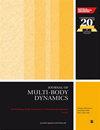Preliminary analysis of vibration characteristics of human body on high-speed train
IF 1.9
4区 工程技术
Q3 ENGINEERING, MECHANICAL
Proceedings of the Institution of Mechanical Engineers Part K-Journal of Multi-Body Dynamics
Pub Date : 2022-02-16
DOI:10.1177/14644193221076348
引用次数: 0
Abstract
To study the ride comfort of high-speed train passengers, a detailed human body–seat–vehicle–track coupled model is developed. This model adopts a dual-axis human-body dynamic model and considers the nonlinearity of the primary and secondary suspensions and the wheel–rail contact condition. Additionally, the input wheel/rail irregularity excitation data are measured for a high-speed railway line in China. According to the model, the root-mean-square (RMS) values of the acceleration for the passenger head at different positions of the car body are determined, and the effects of the car-body loading conditions, speed, and seat support parameters on the head vibration characteristics are studied. The results indicate that the RMS value is the highest for the passengers sitting in the front row near the window seat, followed by those sitting in the middle row of the car body. There are small differences in the RMS value between the passengers sitting on the left and right sides of the same row in the car body. At a certain speed, the track irregularity stimulates the rolling and pitching motions of the train. Therefore, effective methods should be implemented to avoid the inherent characteristics of the car body. Although an increase in the seat support stiffness intensifies the high-frequency vibration, it reduces the low-frequency vibration in the range of 0–15 Hz, reducing the RMS value of the head acceleration. When the train is loaded, the effect of passengers on the car body is similar to that of a damper or mass element, which can reduce the car-body vibration and enhance the ride comfort.高速列车上人体振动特性初步分析
为了研究高速列车乘客的乘坐舒适性,建立了详细的人体-座位-车辆-轨道耦合模型。该模型采用双轴人体动力学模型,考虑了主次悬架和轮轨接触条件的非线性。此外,还测量了中国某高速铁路线的输入轮轨不均匀励磁数据。根据该模型,确定了乘客头部在车身不同位置处加速度的均方根值,并研究了车身加载条件、速度和座椅支撑参数对头部振动特性的影响。结果表明,前排靠窗座位的乘客的RMS值最高,其次是车身中间排的乘客。坐在车身同一排左右两侧的乘客的均方根值差异不大。在一定速度下,轨道的不规则性刺激火车的滚动和俯仰运动。因此,应采取有效的方法来避免车体的固有特性。虽然座椅支撑刚度的增加加剧了高频振动,但它降低了0-15 Hz范围内的低频振动,降低了头部加速度的RMS值。列车装载时,乘客对车体的作用类似于减振器或质量元件,可以减少车体振动,提高乘坐舒适性。
本文章由计算机程序翻译,如有差异,请以英文原文为准。
求助全文
约1分钟内获得全文
求助全文
来源期刊

CiteScore
4.10
自引率
11.10%
发文量
38
审稿时长
>12 weeks
期刊介绍:
The Journal of Multi-body Dynamics is a multi-disciplinary forum covering all aspects of mechanical design and dynamic analysis of multi-body systems. It is essential reading for academic and industrial research and development departments active in the mechanical design, monitoring and dynamic analysis of multi-body systems.
 求助内容:
求助内容: 应助结果提醒方式:
应助结果提醒方式:


